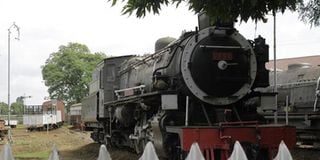Nairobi Railway Museum, where time stood still

One of the locomotives on display at the Railways Museum in Nairobi, which boasts items dating back to the early 1900s. PHOTO | FILE
What you need to know:
- The Nairobi Railway Museum is a place so filled with history that it seems almost haunted
- In many ways, walking through the museum is like travelling through the whole stretch of that period in Kenya
The small plastic box seems rather inadequate to hold such a disturbing past. Its contents, which have been preserved for 114 years, are a grim reminder of a bloody history: Three claws clipped from one of the man-eaters of Tsavo, a pair of lions that terrorised labourers building the Mombasa-Uganda railway.
The box, of course, does not tell the whole story. For that, you have to get out of the curator’s office, cross the lawn outside and there it is, the carriage from which game hunter, Supt Charles Ryall, was dragged to his death at Kima Station on 6 June, 1900, by the very lion whose claws you have held in your hand.
“Ryall intended to lure the lion into the carriage with the aim of killing it,” Elias Randiga, the Nairobi Railway Museum curator explains. “He had stationed lookouts at the back of the carriage and left the door and windows ajar. Unfortunately, he fell asleep and did not hear the lion pad up to the door.”
The two lookouts, frozen with fear, held their breath as the lion melted into the darkness and lived to tell the story.
The Nairobi Railway Museum, located near the Technical University of Kenya (formerly the Kenya Polytechnic), is a place so filled with history that it seems almost haunted.
Here, time has stood still for decades, since the last steam locomotives huffed their way across the country and came to roost here, gathering rust.
The grass has been mowed, revealing the rail tracks and somehow robbing the museum of its prior ruggedness.
A camera crew is here for a photo shoot. A model perches suggestively on the top of a carriage, her hair falling to the side. The photos will appear as a centre-spread in a glossy lifestyle magazine, which somehow makes artistic sense because the carriage her handlers have chosen — No. 301, built in 1923 and retired in 1971 — was used in the epic film, Out of Africa, which won seven Academy awards and starred Robert Redford and Meryl Streep.
THE LUNATIC EXPRESS
The Railway Museum was opened in 1971 as a learning centre on the history of rail travel in East Africa. According to Randiga, it receives between 6,000 and 7,000 visitors annually, mostly foreigners. “We could receive more visitors, there is a lot of history to learn here,” he says.
The museum has in the past offered jaunts on the old trains, giving patrons the experience of now-dated train travel.
It exposes the background of the Kenya-Uganda railway line, aptly nicknamed the Lunatic Express, whose construction is believed to have cost more than 2,500 lives through tropical diseases, murderous heat, and man-eating lions.
It is estimated that four workers died for each mile of the 931-kilometre railway line. You can almost feel the fear in the eyes of the construction workers staring at you from the pictures on the museum walls.
In addition to yellowed reprint posters, which include one offering the extraordinary amount of £100 (Sh15,000 at today’s exchange rates) as a reward for the pelt of the man-eating lions, another advertising Kenya as “a winter haven for aristocrats”. The museum has a collection of relics dating back to the early 1900s: A tortoise calculator here, an antiquated telephone receiver there, a manual typewriter, an officer’s bicycle.
But to experience history, nay to relive the entire experience, you have to clamber up the rickety stairs into one of the locomotives’ chambers and have your ticket punched.
Sink into the worn leather seat and look through the window and everything comes to life: Here you are, travelling across rural Kenya, the train whistle drawing wide-eyed, barefoot children out of mud huts to witness the spectacle. Through plains, past startled zebra and wildebeest. Past Tsavo, you hear the evil laughter of the hyena as night falls.
In many ways, walking through the museum is like travelling through the whole stretch of that period in Kenya, starting with the annexation of Kenya as a British protectorate, and later colony, to the freedom struggle and independence.
It is all here in the sepia-coloured framed photographs adorning the walls, and of course in the trains parked outside. It is all here in the pictures of turbaned Indian workers laying the railway line and displaying their entrepreneurial genius along the way.
Movies and books have romanticised the idea of train travel and railway tracks, and for good reason; there is a pull and endlessness to it, the whistle bringing a loved one back home, or maybe a letter; the clanking of the carriages on the margins of town. The haunting feeling of the death of dreams and the renewal of others play out as the train pulls out of the station.
There is something at the end of that train ride too. If everything remains on track, in a couple of years’ we will begin the journey all over again. However, the journey from Mombasa to Nairobi will take a much shorter time.
But maybe we will have lost something along the way: The inevitable companionship in those 12 or so hours on the hissing train, or the pull of the slow scenery through the window. Instead of a hard-bound book, you will flip open a tablet to peruse the news of the day.
However, in this museum, everything is safe forever. There is no threat of modernity finding its way here, no electric-powered snakes or electronic tickets. There is a talismanic shroud keeping things this way.




